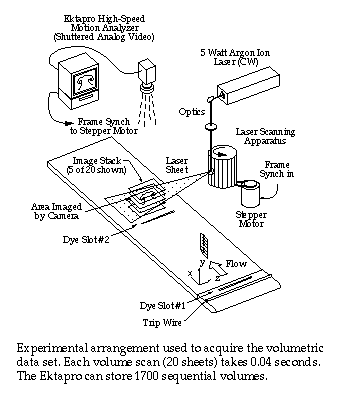Acquisition of the Volumetric Data Set
The flow studied was a turbulent boundary layer with a Reynolds number based on momentum thickness of 700. The experiment was done on a flat plate in a water channel facility. The flow was seeded from two dye slots with disodium fluorescein dye. The dye was illuminated using an innovative laser scanning apparatus developed during the course of this research. The scanner sweeps twenty parallel laser sheets at high speed through a region of the boundary layer. Up to 1700 sequential volumes, each consisting of 20 laser sheets, can be acquired during one experiment. The imaged laser sheets are digitized and stored, and can be rendered in software from any angle. The rendering algorithm includes parallax, transparency and depth-cueing. Pairs of views corresponding to binocular vision can be combined to construct stereoscopic visualizations of the data set. These stereoscopic images can be displayed as a time series, in the form of a 3-D movie. The figure below shows the experimental setup used to gather the data set.
